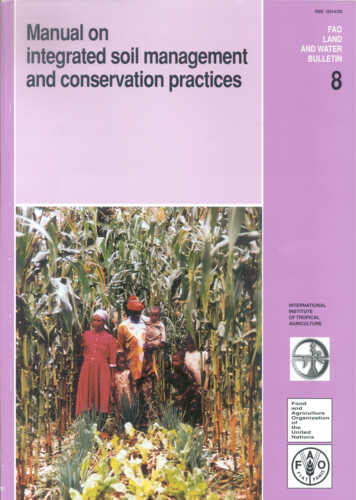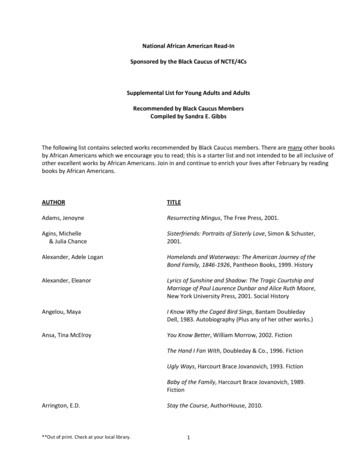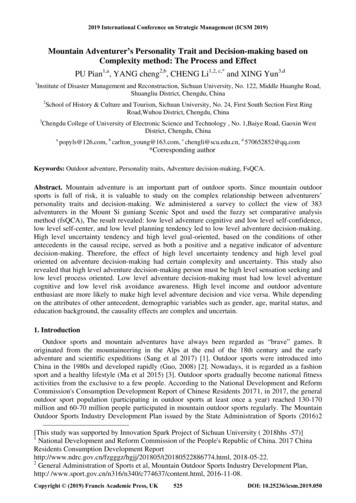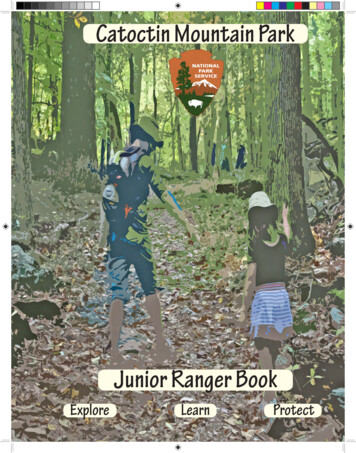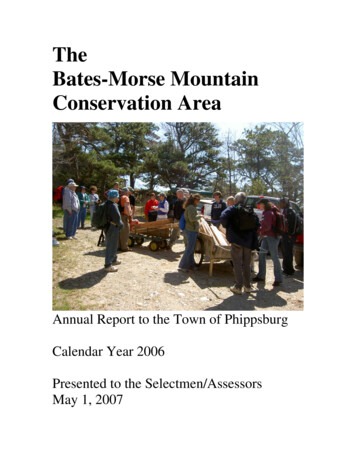
Transcription
TheBates-Morse MountainConservation AreaAnnual Report to the Town of PhippsburgCalendar Year 2006Presented to the Selectmen/AssessorsMay 1, 2007
The Bates-Morse Mountain Conservation AreaAnnual Report to the Town of PhippsburgThrough the Selectmen/AssessorsCalendar Year 2006(as required by the terms of the September 12, 2001 Letter Agreement between BatesCollege, as Agent for the Bates-Morse Mountain Corporation, and the Town ofPhippsburg, and as continued by the new letter agreement dated November 15, 2006.)Research, Scientific, Literary and Academic ActivitiesNon-Bates GroupsThe Bates-Morse Mountain Conservation Area encourages use by outside groups forpurposes consistent with its mission as a scientific and literary institution. In the 2006calendar year, recorded uses included: Chewonki Foundation/Pike School of Andover, MA program (10 9th Graders)McMahon Elementary School (Lewiston, Mr. Beaulieu, 65 5th graders)Bowdoin College Environmental Science Department: annual data collection andanalysis to monitor effects of Sprague River Salt marsh Restoration Project.(Professors Lichter, Vasudevan, Ms. Olmstead)Bowdoin College, Leadership training, natural history session, Ms. Olmstead (16)Hyde School, Bath: 2 field trips (8 students, 16 students)The Thursday HikersLewiston High School (Biology class field trip, 2 days, 45 students each) Mr.McGrawHyde School athletics (32)Boy Scout Pack #639, Bowdoinham. Birding expedition, 23 participants.Westbrook Field trip (28 )Maine Audubon Society Coastal Maine Bird Studies for Teens (15)The Nature Conservancy (2 educational field trips, 13 and 20 respectively)Riverview Foundation, Topsham (24)Ripple Effect children’s leadership group (Leah McDonald) 7Maine College of Art, Coastal Ecosystems (Professor Vollmer),11Maine Audubon Society Shorebird Birding Trip (3)Maine Audubon Society Hog Island Camp, Ornithology (15)Chewonki Foundation Maine Coast Semester (4 trips/year; 40 per trip)Chewonki Foundation field trip (20)Camp NewFound, South Paris (21)Colby College, independent study, vascular plants of the coast (Professor Stone)Small Point Summer School (25)Brunswick High School Cross Country Team (35)
Bowdoin College Freshman Orientation (20)Bowdoin College, Behavioral Ecology and population Biology, ProfessorWheelwright, Ms. Olmstead, (14)Maine Outdoor Adventure Club (10)Maine Audubon Society moonlight beach hike (5)Waldorf School, Marine Invertebrate Studies (31)Merrymeeting Audubon Society, Spring Warbler Walk and Fall Hawk Watch(about 20)Bowdoin College, Biology 219, Biology of Marine Organisms, ProfessorJohnson, Ms. Brown (2 days, 12 and 15)Wiscasset Cross Country Team (10)Colby College, Wetland Science and Policy (Professor Bohlen)Bowdoin College Parents and Families Weekend trip (30)Winthrop Public Schools (35)Bates College’s Research, Scientific, Literary, and Academic use during the yearincluded:Classes Biology: Andrew Stowe, senior thesis on Sharp-tailed Sparrows(and public presentation to community at Popham Chapel House) Geology: Limnology and Paleolimnology of Maine Lakes (GEOs31): studies of 4lakes in Phippsburg (Meetinghouse Pond, Sprague Pond, Silver Lake, Big Pond),Professor Mike Retelle (15)(and public presentation to community at Town Hall) Environmental Studies: Human-Altered Ecosystems (EC/ES s33), ProfessorsHolly Ewing and Lynne Lewis (12) History: Historical Methods/Coastal Communities (HIST s40), Professors DennisGrafflin and Karen Melvin (50) German: Nietzsche, Kafka and Goethe (GER 290) Professor Dennis Sweet (8) Biology: Avian Biology (BIO 335), Professor Ryan Bavis (10) Biology: First Year Seminar “Issues in Oceanography” (FYS 282), Professor WillAmbrose Geology: First Year Seminar “Exploring Maine Geology” (FYS 327), ProfessorDyk Eusden Geology: Sedimentary Environments and Processes (GEO 210), Professor MikeRetelle Environmental Studies: Soils (ENVR 210), Professor Holly Ewing (10) Dance: Green Horizons Project, Professor Carol Dilley (5)Other Bates Woman of Color Retreat Deansmen Retreat Within Reach Retreat Bates Reunion Class Field Trips, Class of 1961 and Class of 1966 Annual Entering Student Orientation Program Trip Bates Christian Fellowship Retreat
Special Projects and EventsSalt Marsh RestorationSprague River Salt MarshBowdoin College’s Environmental Studies Department continues to monitor the twoareas of the Sprague River Salt Marsh where man-made ditches were plugged in 2000and 2002 respectively. Judy Marden meets each class and introduces them to theConservation Area with a history of the area, its use for salt marsh haying, and the projectwhich plugged the ditches and increased the tidal flow. Under the direction of NancyOlmstead, and Professors Dharni Vasudevan and John Lichter, the ES 201 studentscollect water and benthic samples from both plugged and unplugged ditches, and bothnatural and created pannes. This year, with Nancy Sferra from The Nature Conservancy,they traveled to Little River Salt Marsh, at Reid State Park in Georgetown, to observe andcompare the differences between a ditched and an un-ditched salt marsh. Little River isbelieved to be the only salt marsh in the state which has not been ditched for either salthay harvesting or mosquito control. They are trying various methods of data collection, tosee if they find significant differences between plugged and unplugged ditches, naturaland man-made pools, and marshes which have and have not been ditched, as well askeeping annual records to see if there may be changes or trends over time. Variousmeasurements include dissolved oxygen, salinity, turbidity, pH, nitrates, phosphates,temperature, kinds and amounts of vegetation, kinds and numbers of macroinvertebrates.A horseshoe used on salt marshes, from Judy Marden’s collection
Morse River Salt MarshWhen the salt marsh restoration project team met in March 2003, one of the projects discussedwas replacement of the old granite culvert under Route 209 where the Morse River flows. Thegroup met with representatives of the Department of Transportation, inspected the culvert inthe field, and recommended that it be replaced with a larger culvert to remediate the tidalconstriction exacerbated by the partially-collapsed granite structure. Tidal constrictions keeplarger quantities of salt water from flowing into the salt marsh north of the highway, thusleaving it more vulnerable to invasion by vegetation which is less salt-tolerant, as evidencedalready by a small stand of Phragmites australis (common reed), which appears to bespreading. In 2004, the DOT removed rock that had fallen into the channel and culvert,allowing a less constricted tidal flow. In September 2006, the DOT replaced the old culvertcompletely with two large metal culverts.ResearchRob Vincent of the University of New Hampshire continued his project which examineshydrologic characteristics and habitat structure and function for man-made features andnaturally-occurring water features on the Sprague marsh.Keryn Bromberg, a graduate student at Brown University, began a project to study the effectsof mosquito ditching on ecosystem processes and services in Maine salt marshes. She hopes todiscover how far from a ditch hydrologic conditions differ from an unditched marsh, howaltered conditions affect species dominance, decomposition and productivity, whether ditching
has altered marsh accretion rates by draining water off the marsh before suspended sedimentshave settled out, and how the effects of ditching in northern New England marshes comparewith those in southern New England marshes (Rhode island and Connecticut).History S-40A course required of all Bates History majors, Introduction to Historical Methods, brought fiftyBates students to Morse Mountain in May 2006, accompanied by Professors Dennis Grafflinand Karen Melvin. After visiting Maine Maritime Museum in Bath, the students met withJudy Marden for an on-site lecture and tour, covering the history of Morse Mountain from itsfirst settlement by Europeans, through salt marsh harvesting and ditching, attempted resortdevelopment in the 1890’s, World War II occupation, and creation of the Conservation Areawith its nonprofit status and conservation easements. The group was very interested in theunique growth of coastal communities, and plans to return to delve into the history in moredepth, including the 400th anniversary of the Popham colony.Bates-Morse Mountain Faculty Advisory CommitteeThe College constituted a new Bates-Morse Mountain Faculty Advisory Committee, whichmet for the first time in January, 2006. Its charge is “to guide and oversee the pedagogical,research, and educational uses of Bates-Morse Mountain, to generate new opportunities foreducational uses and connecting Bates-Morse Mountain to the educational work of BatesCollege, and to give the staff of the Harward Center advice about ethical, ecological, or otherissue that may arise.” Members of the new committee are Aslaug Asgeirsdottir (PoliticalScience), Holly Ewing (Environmental Studies), Beverly Johnson (Geology), Michael Jones(History), Camille Parrish (Environmental Studies), Michael Retelle (Geology), and CarlStraub (Professor Emeritus of Religion and Environmental Studies). A subgroup of this
committee, with additional members who may be involved in specific areas of research,reviews all proposals for research projects at Morse Mountain. Camille Parrish, of the BatesEnvironmental Studies Department, is developing a system of GIS maps to keep track ofvarious projects, to ensure that no one’s research will encroach upon or adversely impact otherprojects, or the environment.Phippsburg SchoolsA program in North Atlantic Studies, involving archaeology studies in the Shetland Islands,gave Bates the opportunity to share a unique resource with the children of PhippsburgElementary School. Two archaeologists, Bob Proctor and Sue Remington, came to the schoolfor two days in May. They set up extensive displays in the library, tailoring the explanations ateach session to the age group present, beginning with the Kindergarten. The first class was onbones, and children were able to handle and compare bones from widely different animals tosee their similarities and differences. The children learned how being able to identify bonefragments at prehistoric sites gives archaeologists insight into food, habits, climate, and otherimportant information about the people who lived there. The second session featured artifactsand tools, and the archaeologists described how they examined ancient sites, how humans usedvarious materials for tools, and how tools were made.Migrating Birds and Endangered SpeciesOnce again the spring weather was inhospitable to arriving birds and breeding populations.Piping Plovers lost many nests early in 2005 because of unusually high tides coupled withfierce storms. Consequently, when they did have successful nests later in the season, they lostmore eggs and chicks to predators. There were also four adult fatalities in Maine in 2005,which impacted the number of adults who came back to breed in 2006. “It can take severalyears for a population to recover from two years of bad weather,” said Jody Jones, coordinatorof Maine Audubon’s Piping Plover and Least Tern Recovery Project. The Piping Plovers thatnest on Seawall Beach are especially vulnerable to predators. A high fox population, andvigilant crows and gulls, seem to be the most persistent enemies.In a recent article in Audubon magazine, Steve Kress, famous for his efforts to restore AtlanticPuffins to historic nesting islands in the Gulf of Maine, said “What we’re trying to do, asseabird stewards, is to replicate sustainable seabird communities in a world that’s beenradically changed by the activities of humans we work with rare and endangered species inan area of the country where the balance of nature has been seriously altered. Thus we’vecome to the sobering conclusion that we’ll never be able to pack up our tents and leave theseabirds to their own devices. The predators simply won’t let us.” The article went on to say“Before the Migratory Bird Treaty Act of 1918, plume hunters seeking feathers to adorn ladies’hats slaughtered gulls by the thousands. The newly organized National Association ofAudubon Societies worked against extremely difficult odds to keep the last gulls in Mainefrom being killed. Now, with tons of free food in the form of garbage, fishing waste, anddiscarded lobster trap bait, gulls are thriving, outnumbering other coastal bird communities inMaine, and causing serious problems ” Piping Plover productivity at Seawall Beach isaffected by the same issues.
Recent statistics:1999: 8 pairs of Piping Plovers nested, there were 10 confirmed fledglings, 14 nesting attemptsand 9 failed nests. Twenty nesting pairs of Least Terns arrived at Seawall, but relocated toLaudholm after nesting attempts were disrupted by predators.2000: 9 pairs of Piping Plovers nested, there were 7 confirmed fledglings, 15 nesting attemptsand 9 failed nests. No Least Terns nested at Seawall in 2000.2001: 6 pairs of Piping Plovers nested successfully at Seawall Beach. While some Least Ternswere observed, apparently the only nests occurred at Wells, primarily at Crescent Surf.2002: 6 pairs of Piping Plovers nested, there were 9 confirmed fledglings, and 11 nestingattempts. High tides and predation were responsible for some of the nest failures. No LeastTern colonies located at Seawall Beach in 2002.2003: 5 (possibly 6) pairs of Piping Plovers nested, producing 3 confirmed fledglings from atotal of 12 eggs. The monitors reported that eggs and chicks suffered unusually high mortalityin 2003. Several nests were washed away by high tides, others were predated by foxes, andeven other Piping Plovers. No Least Terns nested in 2003.Piping Plover eggs in a scrape: Photo by Bryan Watson2004: though 13 adult Piping Plovers were seen, only 4 pairs nested, producing 7 confirmedfledglings after 8 nesting attempts. Least Terns were seen in the area; a colony attempted tonest at Reid State Park for the first time in recent years, but was not successful.2005: 10 Piping Plover nesting attempts were counted (some pairs attempted nesting twicewhen their nests were destroyed) and three chicks were observed, but apparently no chicksfledged successfully. A colony of Least Terns attempted to nest at the Morse River end ofSeawall Beach on July 4, with two nests observed, but both eggs and terns had disappeared byJuly 7.2006: Observers saw five pairs of Piping Plovers, with 8 nesting attempts (several tried twicewhen their eggs were destroyed). Four fledglings were counted, with two more late-season
chicks observed on the last day of August, assumed to have fledged successfully, bringing thetally to 6. No Least Terns attempted to colonize.Seawall Beach and the marshes of the Bates-Morse Mountain Conservation Area arerecognized as critical staging areas for migrating shorebirds, which nest in arctic and sub-articregions and winter as far south as South America. The area provides protected feeding andresting habitats for migrants, and breeding habitat for a diverse variety of other birds, animals,insects, and fish. Areas such as this along the New England coast have become increasinglythreatened by degradation from development, environmental contaminants, and human-relateddisturbances, making the protected complex kinds of habitat in the Conservation Area evenmore crucial to the survival of a diverse array of life.Invasive Species: Purple LoosestrifeEach year, staff members from The NatureConservancy and Bates-Morse Mountainstaff members monitor vegetation plots inthe area behind the dunes where a sectionof marsh has been invaded by PurpleLoosestrife. They collect vegetation datafrom ten plots, and compare the data fromyear to year. On June 22, 2006, their datacollection was hampered by the spring’suncommonly wet weather.When they went back to check in August,not only had the plots dried up, butapparently some seeds had been transportedby water to more widespread locations.The loosestrife was flowering abundantly.Though we cut flower heads on multipledays to help contain the spread of seeds,more radical control measures may becomenecessary.
Other eventsTwo major alterations happened at Morse Mountain during 2006, one intentional, and theother, natural.In April, the bridge on Morse MountainRoad spanning the Sprague River wascompletely replaced, by Mark Hawkes’crew.Just before Thanksgiving, a “microburst,”or small tornado, skipped across thepeninsula, felling trees at Flat Point, thenacross Morse Mountain Road and in a linefurther into the woods, blocking the roadand taking down power and telephonelines. Dan Gurney removed over thirtylarge fallen trees.OutreachThe Friends and Neighbors of Morse Mountain met twice during the calendar year, once inJune and again in December. At the June 19th meeting, the group (which is comprised ofadjoining landowners, members of the Small Point Association, Town officials, members ofthe St. John family, members of the Bates-Morse Mountain Corporation, staff members fromthe Nature Conservancy and their volunteer easement monitor, and representatives from BatesCollege) discussed the charge of the committee, the upcoming summer, and the potentialimpact of increased development in the area. David Scobey introduced the new AssociateDirector of the Harward Center for Community Partnerships, Anna Sims Bartel, to the group.The second meeting, in December, reviewed the summer’s visitor statistics, and introducednew Harward Center staff member Ellen Alcorn, Coordinator of Service Learning. Ellen hadjust come from a meeting with the Principal at Phippsburg Elementary School. With abackground in education, she is looking forward to facilitating close collaboration with thePhippsburg teachers and students.
A new program, the “Bates-Morse Mountain Forum Series” began in June 2006, building uponthe College’s desire to share ongoing academic work and information generated at MorseMountain with the Phippsburg community. The first Forum, held at the Popham Chapel Housewith the help of Bill Murray and Elizabeth Watson, was presented by Andrew Stowe’66. Hespoke about his breeding bird surveys, particularly his thesis work on Sharptailed Sparrows.Drew spent early mornings throughout the summers of 2004 and 2005 studying and recordingbirds, both at Morse Mountain and Atkins Bay. His exceptional research won him theprestigious Watson Fellowship, which he is using to track the Arctic Tern in its around theworld migration patterns during 2006-2007.The second Forum, held at the Phippsburg Town Hall, was the occasion of Geology ProfessorMichael Retelle’s second presentation to the Phippburg community. Mike has a long history ofbringing research, classes, and field trips to the Phippsburg area. His presentation last year wason many years of tracking beach erosion and deposition on Seawall Beach, but this year, Mikeand his Limnology Class collaborated with the town and the Phippsburg Land Trust on acompletely different kind of project. They studied four fresh water lakes and ponds inPhippsburg: Silver Lake, Meetinghouse Pond, Big Pond, and Sprague Pond. They usedmorphometry (measurement of lake size and shape), water column studies, and sediment corestudies, and will share their findings with the Town and the Land Trust. A related part of theirproject compares characteristics of lakes in central Maine and in the White Mountains.In November, David Scobey and Judy Marden met with the Phippsburg Board of Selectmen todiscuss renewal of the College’s letter agreement with the Town. As a tax-exempt property,the Conservation Area pays no property tax, but has, instead, agreed to a payment-in-lieu-oftaxes to cover town services. The meeting resulted in a third five-year agreement, with a selfrenewal for another five-year period if neither party asks to renegotiate. Both the Selectmenand the Bates representatives reaffirmed the importance of connecting Bates faculty andstudents with the Phippsburg Elementary School and other local educators and students. Theinclusion of the Bates-Morse Mountain Conservation Area within the Harward Center forCommunity Partnerships increases the numbers of opportunities for Bates and Phippsburg towork together on educational projects. The annual Morse Mountain Workday, now heldannually in May, brings other members of the Bates Community to Phippsburg to work withvolunteers, Maine Audubon, The Nature Conservancy, the St. John family, and others to learnabout endangered species and to erect protective fencing and signage at nesting areas onSeawall Beach. Bates looks forward to increasing these opportunities to learn and worktogether for mutually beneficial collaboration.Respectfully submitted.Judith A. Marden, DirectorBates-Morse Mountain Conservation Area
Geology: First Year Seminar "Exploring Maine Geology" (FYS 327), Professor Dyk Eusden Geology: Sedimentary Environments and Processes (GEO 210), Professor Mike . Two archaeologists, Bob Proctor and Sue Remington, came to the school for two days in May. They set up extensive displays in the library, tailoring the explanations at




